Village architecture in the Zayanes’ region: A renewable cultural pattern
Issue 58

Jawad Al-Tiba’i
Prior to Morocco's independence, the tribe was in charge of regulating environmentally appropriate housing. With the changes in land administration and national rebuilding in the early 1960s, the tribe's function shrank to allocating communal lands to individuals, regulating land rights and arranging yearly religious and cultural seasons. The village groups, with their elected representatives, took over management of urban agglomerations from the tribe. Gradually, construction started using cement and solid materials rather than local resources for family buildings, and livestock and agricultural equipment facilities were separated from the residential units.
Village housing was not a priority for administrations whose primary purpose was to oversee the general affairs of the village community. However, village housing in the Zayanes' region has always been an important part of tangible cultural heritage. It shows cultural and symbolic potential as well as the ability of communities to work together.
Housing sizes vary depending on the family's economic status. The geometric shape of the house shows how simple the design is, and the number of rooms and space shows how big the family is, how they socialize, and how close they are to each other.
The Zayanes region's houses store crops and food, provide shelter for animals and livestock, and preserve agricultural equipment. It reflects its natural surroundings' data, whether in terms of building materials or adaption to climatic, topographical, and security situations. Given its ecological significance, it is vital to connect rural heritage with tourism activities so that the sense of the place's spirit is consolidated and it returns to its normal vitality, as is the case in some of the areas in the Draa Valley and the Madasher mountains to the northwest.


































































